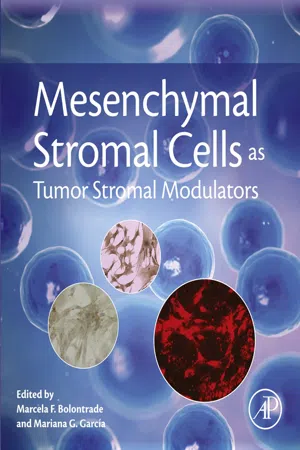
- 642 pages
- English
- ePUB (mobile friendly)
- Available on iOS & Android
Mesenchymal Stromal Cells as Tumor Stromal Modulators
About This Book
Mesenchymal stromal/ stem cells (MSCs) represent a heterogeneous cell population with immunomodulating, tissue repairing, differentiating, migratory and angiogenic abilities, making them important tools for clinical and translational research. An understanding of the role of MSCs in modulating tumor growth provides a glimpse into their role in non-pathological tissue remodeling and potential regenerative tissue therapies.
Mesenchymal Stromal Cells as Tumor Stromal Modulators is a comprehensive source for the understanding of the role of MSCs as ubiquitous connective tissue cell components, which may have both direct and indirect effects on the tumor microenvironment and potential for regenerative therapeutics for various diseases. Using cancer as a model disease, this book explores the transformative role MSCs play in the recruitment of disease cells, cell repair and immunological defenses.
- Explores the biology of mesenchymal stromal cells (MSCs) and tissue related function
- Discusses the bidirectional communication between tumor stroma and MSCs derived from bonemarrow, from adipose tissue and from other tissue types
- Provides in-depth analysis of the effects of MSCs on key processes that regulate disease progression, such as angiogenesis, metastatic potential, invasion, proliferation, tumor immune privileges
Frequently asked questions
Information
What Are Mesenchymal Stromal Cells? Origin and Discovery of Mesenchymal Stromal Cells
Abstract
Keywords
Introduction
The Discovery of Mesenchymal Stromal Cells in Bone Marrow
The Osteogenic Potential of Bone Marrow Cells, a Feature Already Described in the 19th Century
The Emerging Concept of “Hematopoietic Stem Cells”
The Discovery of a Common Mesenchymal Precursor in Bone Marrow
Table of contents
- Cover image
- Title page
- Table of Contents
- Copyright
- List of Contributors
- Preface
- 1. What Are Mesenchymal Stromal Cells? Origin and Discovery of Mesenchymal Stromal Cells
- 2. Mesenchymal Stem/Stromal Cells From Adult Tissues
- 3. Mesenchymal Stem/Stromal Cells From Neonatal Tissues
- 4. Mesenchymal Stem/Stromal Cells Derived From Pluripotent Stem Cells
- 5. Mesenchymal Stem/Stromal Cells as Biological Factories
- 6. MSC Recruitment From Distant and Local Tissues in Homeostasis and Tissue Remodeling
- 7. Mesenchymal Stem/Stromal Cell Trafficking and Homing
- 8. Tumor-Secreted Factors That Induce Mesenchymal Stromal Cell Chemotaxis
- 9. Mesenchymal Stromal Cell Recruitment by Gastrointestinal Carcinomas
- 10. Mesenchymal Stem/Stromal Cell Recruitment by Central Nervous System Tumors
- 11. Mesenchymal Stem Cell Transition to Tumor-Associated Stromal Cells Contributes to Cancer Progression
- 12. Mesenchymal Stromal Cells and Tumor Angiogenesis
- 13. Role of MSCs in Antitumor Drug Resistance
- 14. Multifunctional Roles of Tumor-Associated Mesenchymal Stem Cells in Cancer Progression
- 15. Mesenchymal Stem Cells as Regulators of the Bone Marrow and Bone Components
- 16. The Bone Marrow Microenvironment as a Regulator of Tumor Dormancy
- 17. Mesenchymal Stem/Stromal Cells and the Tumor Immune System
- 18. The Inflammatory Environment and Its Effects on Mesenchymal Stem/Stromal Cells
- 19. All Aboard: Mesenchymal Stem/Stromal Cells as Cell Carriers for Virotherapy
- 20. Engineered Mesenchymal Stem/Stromal Cells for Cellular Therapies
- 21. Extracellular Vesicles From Mesenchymal Stem Cells and Their Potential in Tumor Therapy
- 22. Therapeutic Purposes and Risks of Ex Vivo Expanded Mesenchymal Stem/Stromal Cells
- 23. Concluding Remarks
- Index